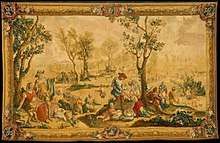Willem de Pannemaker
Willem de Pannemaker (ca. 1510 – 1581), was a notable Flemish tapestry creator from the 16th century. He was the head of the Pannemaker tapestry workshop, was considered the greatest tapestry creator for his time, and is best known for his works for the Habsburgs.[1]
Biography
Pannemaker was born circa 1510 in Brussels. His father Pieter was head and most famous member of the Pannemaker family tapestry workshop in Flanders.[2] Trained by Pieter, Willem rose to become the most renowned tapestry weaver in contemporary Europe, many of his pieces being purchased by the Habsburg court during the 1540s and 1560s.[2][3] He derived particular artistic inspiration from the works of Raphael.[1] One of his best-known pieces is the Conquest of Tunis. He died in 1581.[3]
Known Works

- Conquest of Tunis - Created after designs by Jan Cornelisz Vermeyen depicting the 1535 Conquest of Tunis by Charles V. It is notable for including one of the first European depictions of a tornado.[4] Pannemaker was entrusted with creating the tapestries in 1548 for the court of Charles V, and completed the 8-part series in 1554. The series was later considered to be the most important piece of art within the court shortly after its creation.

- The Wedding of Mercury - This 8-part series is currently the only surviving series that depicts the myth of Mercury and Herse as mentioned in the Metamorphoses by Ovid.[1]

- The Months of Lucas - The series is named after Lucas van Leyden, a sixteenth-century artist believed to have designed it. It depicts scenes from the out-of-doors lives of nobles and peasants during the twelve months in twelve pieces.[5]
- Christ Appearing to Mary Magdalene (Noli Me Tangere) - Created between 1540/45. The design is likely from either Michiel Coxcie or Giovanni Battista Lodi da Cremona.[6]
References
- "Prado Museum Exhibits Tapestry Series by Willem de Pannemaker". artdaily.com. Retrieved 2019-04-15.
- "Pannemaker". Academic Dictionaries and Encyclopedias. Retrieved 2019-04-15.
- "The Loves of Mercury and Herse. A Tapestry Series by Willem de Pannemaker - New". Museo Nacional del Prado. Retrieved 2019-04-15.
- Hoinka, Klaus P.; de Castro, Manuel (2005-04-01). "A Renaissance Depiction of a Tornado" (PDF). Bulletin of the American Meteorological Society. 86 (4): 543–552. doi:10.1175/BAMS-86-4-543. ISSN 0003-0007.
- "Joslyn Art Museum Omaha Nebraska | Art Museum, Art Classes Omaha Nebraska | Entertainment Omaha". www.joslyn.org. Retrieved 2019-04-15.
- "Willem de Pannemaker". The Art Institute of Chicago. Retrieved 2019-04-15.
Further reading
- Ortiz, A.; Carretero, C.; et al. (1991). Resplendence of the Spanish monarchy : Renaissance tapestries and armor from the Patrimonio Nacional. New York: The Metropolitan Museum of Art. (see index)
| Wikimedia Commons has media related to Willem de Pannemaker. |